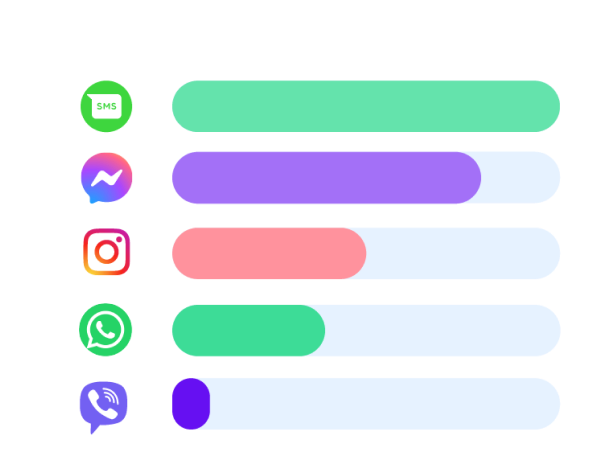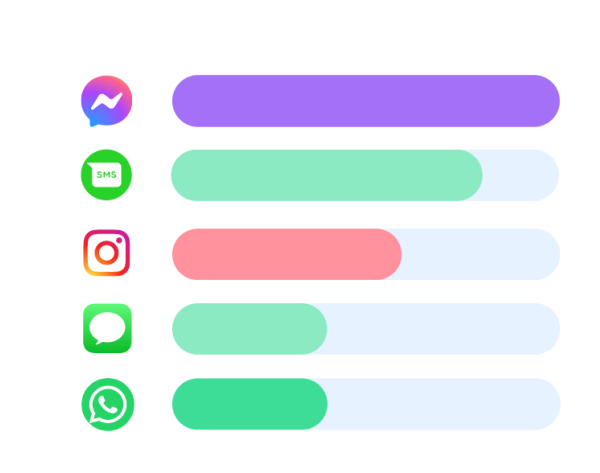- SMS: A Short Message Service Summary
- The Big Numbers of SMS Messaging
- SMS Messaging Use Cases
- 1. Update & Alert Customers With SMS
- 2. Engage Customers Via SMS
- 3. Increase Security With SMS
- The Audience of SMS Messaging
- Sweden's Favorite Channel
- SMS Popularity in North America
- SMS Messaging in Asia
- The Added Value of SMS
SMS: A Short Message Service Summary
Launched in the 1990's, SMS (Short Message Service) allows users to send and receive short and simple text messages on mobile phones via two-way communication. SMS messages consist of plain text, without fluff or rich media, and there's a 160 character limit to each message. There are no specific requirements needed: a valid phone number and a service plan to send and receive text messages is enough. The SMS app is native on every mobile phone, which means that receiving SMS messages is already hard-wired into all mobile devices worldwide. This makes SMS a powerful tool for businesses to reach their audience.
The Big Numbers of SMS Messaging
Every mobile phone has a native SMS app built in, which gives SMS an extensive global reach. As of 2023, there were almost 8.9 billion mobile phone subscriptions worldwide. That even exceeds the global population of 7.9 billion! Often, people have multiple subscriptions to meet various personal or work related demands.
SMS also boasts open rates as high as 98%, which means that your messages not only reach the phones of your audience, those messages will also actually be read. This is further proven by the fact that 85% of surveyed people in 2023 admitted to prefer receiving text messages over email or phone calls. As many as 45% of people will engage with branded text messages - or conversational marketing messages- they receive.
SMS Messaging Use Cases
These high reach and engagement numbers are great, but how exactly can you benefit from them? Well, the most common use cases of SMS for business are A2P messaging, or Application-to-Person messaging. It means that these SMS messages are sent from an application to a person, rather than Person-to-Person (P2P). Sounds complicated? It really isn't. A2P messaging is everywhere in our daily lives - from receiving order confirmations when online shopping to getting marketing messages about new product restocks - A2P messaging is suitable for a huge number of use cases. Let’s look at a few.
1. Update & Alert Customers With SMS
The high open rates and engagement rates make SMS a timely channel - perfect for sending out time-sensitive notifications, updates and alerts. Order confirmations via SMS with details such as a confirmed date, time and/or location will instantly provide your customers peace of mind after scheduling an appointment or purchasing a product online. Sending appointment reminders and tracking or delivery updates via text will help reduce no-shows by keeping the appointment or delivery top-of-mind for your customers. And even if your delivery runs a little late, these updates help inform your customers, effectively reducing the impact on your live agents. And because sending and receiving SMS messages rarely takes more than a few seconds, it is also a great channel to send crucial notifications in the event of important updates or disturbances.
2. Engage Customers Via SMS
SMS is a perfect tool for customer engagement, both in terms of support and marketing. You can use SMS to start a two-way conversations with customers, helping them with their queries and assisting them in their customer journey. In fact, 97% of companies found they communicated with customers more efficiently after launching texting initiatives. Besides being a quick way to offer support, this more personal way of communicating with customers also builds trust and loyalty. 45% of consumers admit that the ability to send mobile messages is what could convince them to choose one brand, product, or service over another. And as many as 66% of consumers say they would pay more for something if it was supported by a mobile messaging channel. Impressive statistics to say the least! And it doesn't stop there. By sending out personalized offers and recommendations via text message, you can entice customers to click to your website or product and give your sales a boost.
53% of consumers say they feel more positive toward a brand that uses mobile messaging to communicate
Use SMS messaging to send promotional campaigns and special offers to thousands of people at a time, but also make sure that the offer is relevant. By linking your SMS solution to your database or CRM (Customer Relationship Management) you can personalize and customize the text messages for an optimal customer experience.
3. Increase Security With SMS
A huge and growing use case of SMS messaging involves security. Lost a password? The website will let you reset it—but you’ll need to enter a six-digit number texted to your phone first. Need to make a large payment? Your bank will want to confirm your identity in a similar manner. Authentication via SMS messaging by sending One Time Passwords, or OTPs, is a growing business use case. Juniper Research even forecasts that the total SMS traffic used for OTP use cases will reach 1,5 trillion by 2028! An increase from the 1,3 trillion measured in 2023.
The Audience of SMS Messaging
The value SMS can add to the above use cases is crystal clear, but does that mean you can immediately implement SMS messaging and see increasing results? Well, that depends. Two important questions in customer communication are: Who is my audience? And what is my use case? Who you're trying to target and what you're trying to achieve largely determines your strategy and communication channels. It's no use to advertise via a messaging channel that your target audience doesn't use.
The rise of social messaging apps such as Facebook Messenger, WhatsApp, and Instagram Messaging certainly put a dent in the popularity of SMS. The most popular messaging channel globally speaking is WhatsApp, whereas SMS is often not even in the top five. Does that mean that SMS is less useful? That stats above certainly show otherwise. But it is important to consider combining the forces of WhatsApp with other popular channels to fully optimize your marketing and customer support efforts.
Sweden's Favorite Channel
There is one country that is still a loyal fan of the reliable text messages, and that country is Sweden. It ranks SMS as their favorite messaging channel, leaving both Messenger and Instagram Messaging behind it.
Most Popular Channels in Sweden

SMS Popularity in North America
SMS also has a large support base in North America: 92 million people use text messages in North America, which is 80% of the total population. Canada even rates SMS as their 2nd most favorite messaging channel, right after Facebook Messenger.
Most Popular Channels in Canada
SMS Messaging in Asia
In Asia there are more messaging channels competing for attention from the audiences. Even the global giants WhatsApp and Messenger have fierce competition from local channels such as Line. Japan is the only country that places SMS Messaging in their top five. However, China and India have the most people who send SMS messages in the world. China comes first with 1,081 million people and India second with 730 million. Though SMS may not be considered the favorite, these are still numbers to be reckoned with.
The Added Value of SMS
The incredible reach and engagement statistics of SMS make it a valuable channel for any business. The rise of social messaging apps may have impacted the popularity of SMS, but it's added value never diminished. Whereas the newer platforms are perhaps stronger in rich features, the strength of SMS shines trough in its reach and reliability. So is it the best choice for your business?
Well, do you have to choose? SMS complements the newer messaging channels greatly. Reach out to customers via their favorite messaging channels and fall back to SMS to make sure you reach everyone. Use SMS Messaging to push your marketing campaigns or authenticate users on your platform, but also reach out to your customers on other socials to fully engage your target audience.
Check out CM.com's SMS Messaging solutions below, and feel free to reach out to one of our experts to discuss the possibilities for your business.
